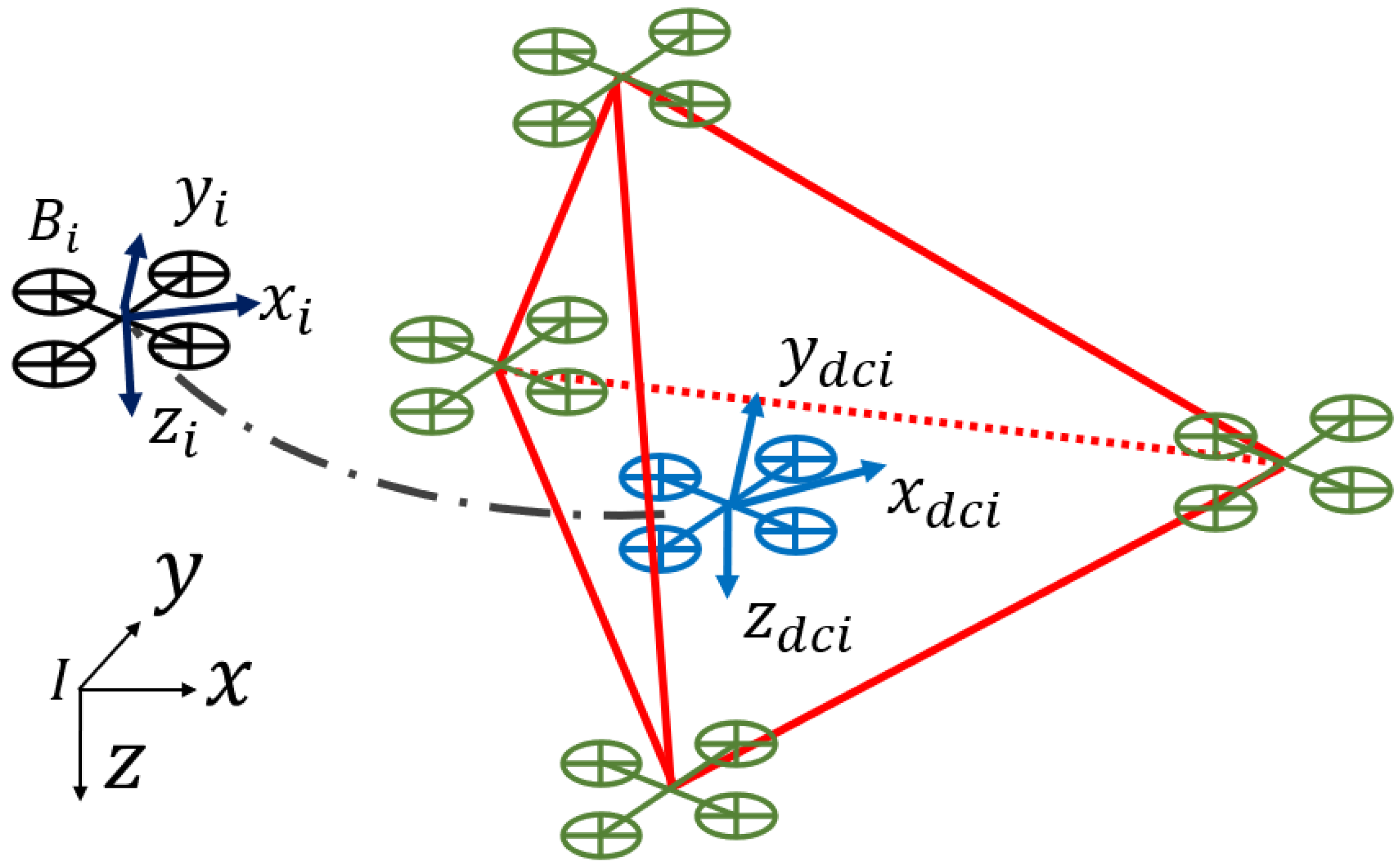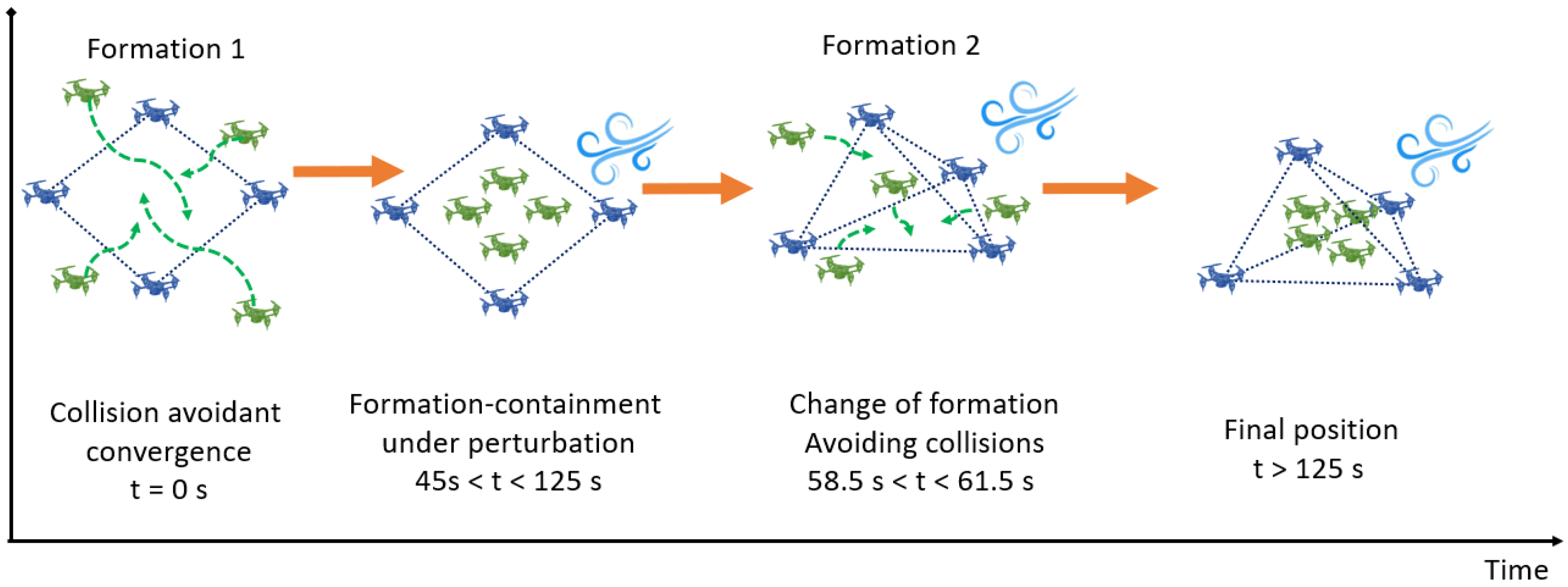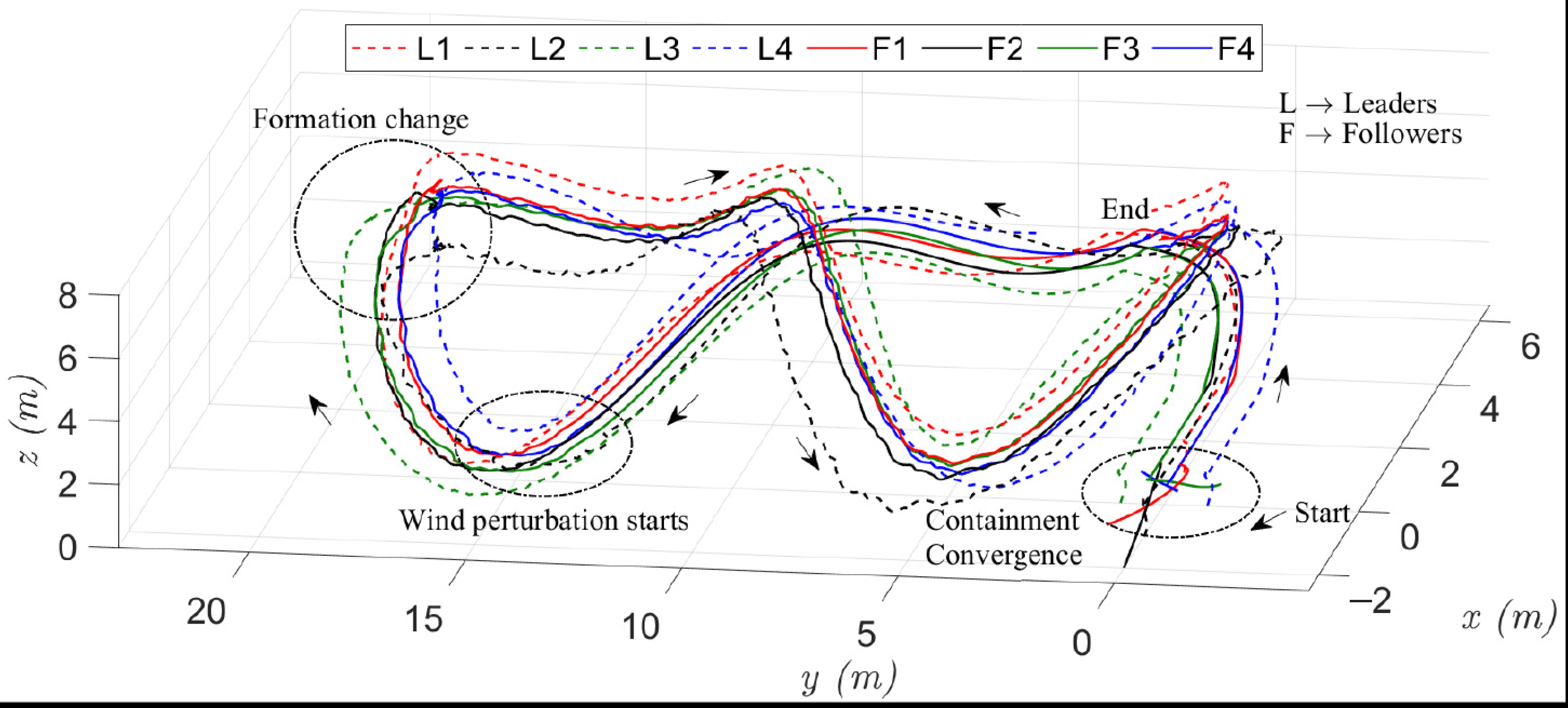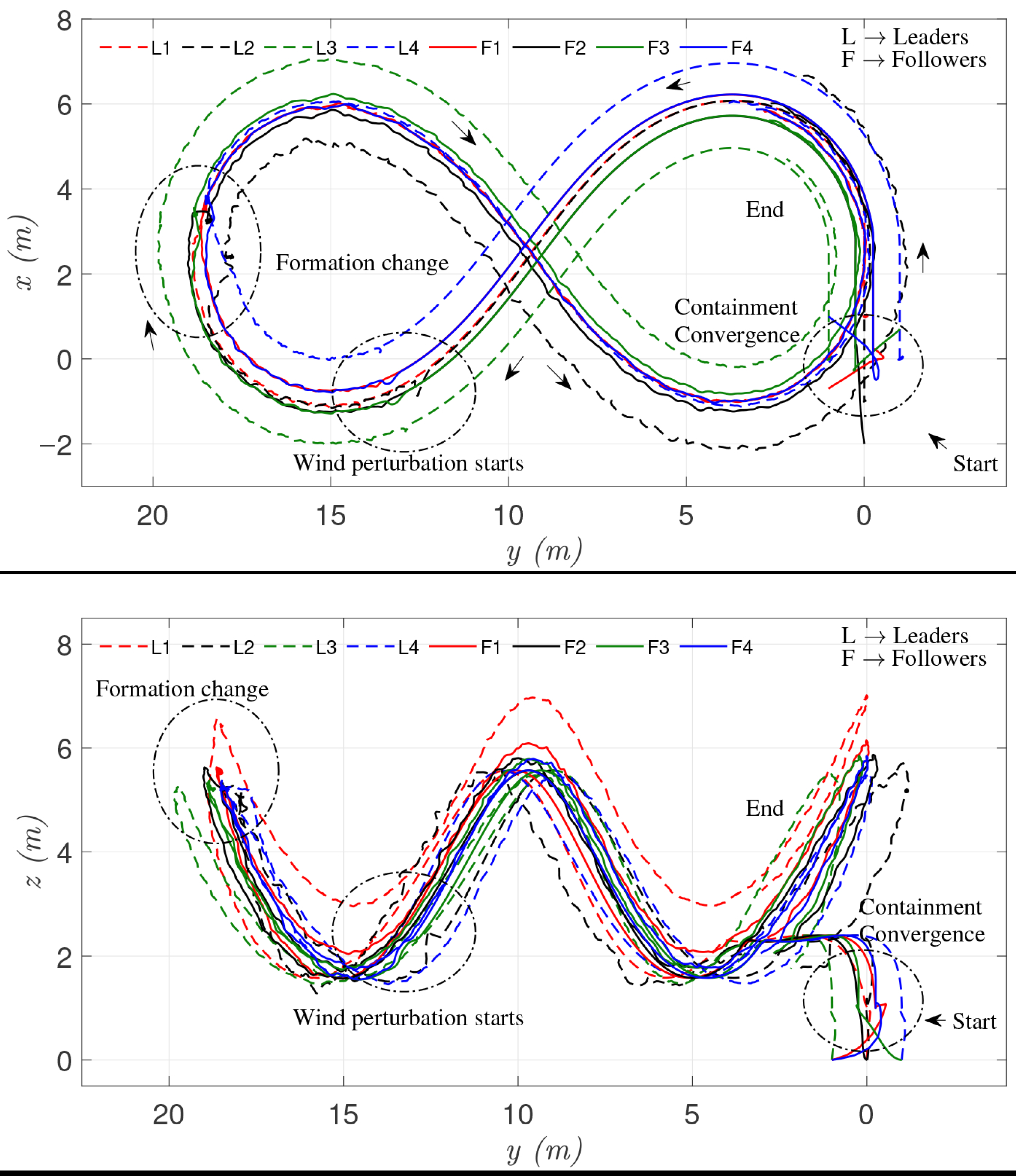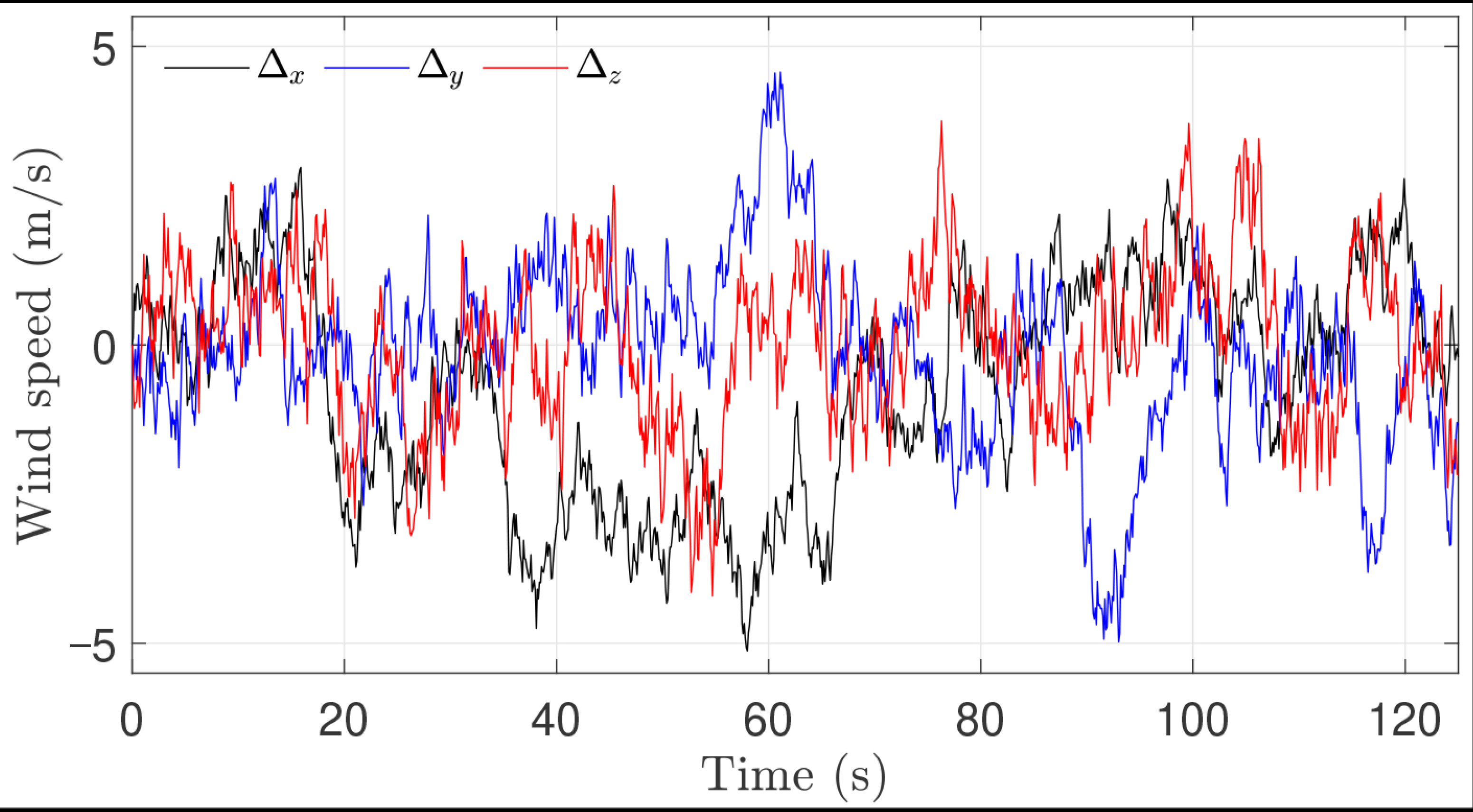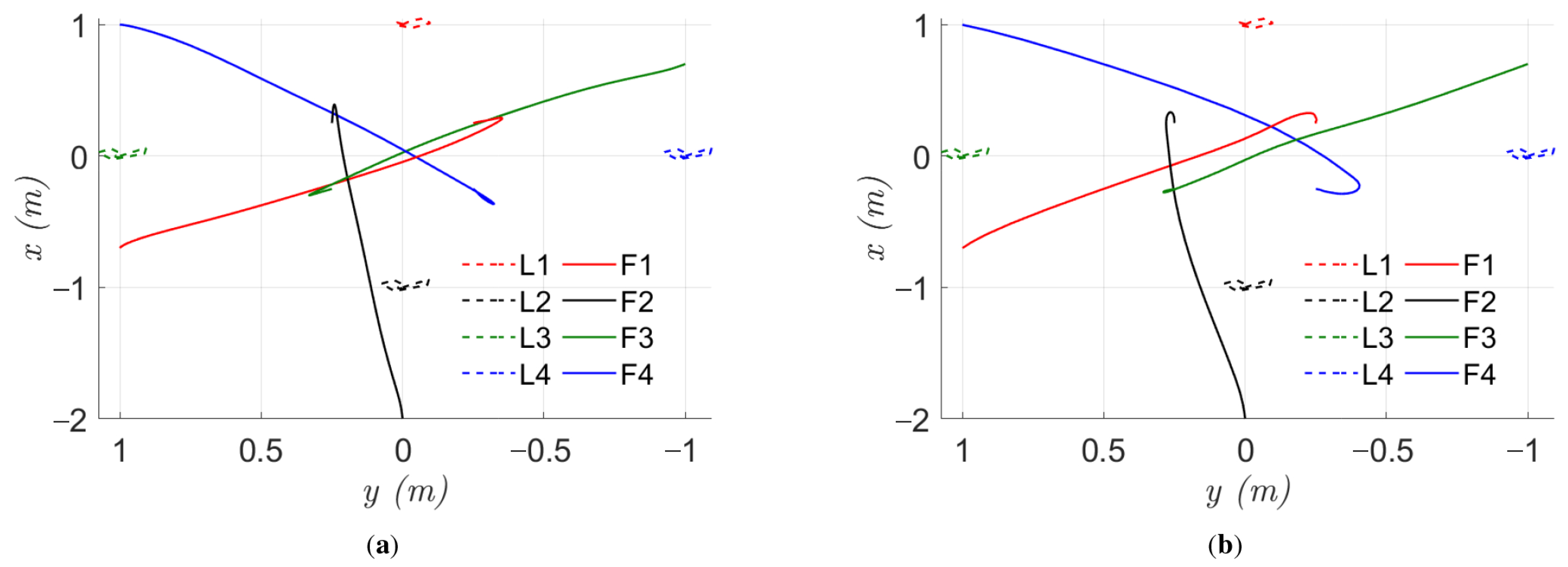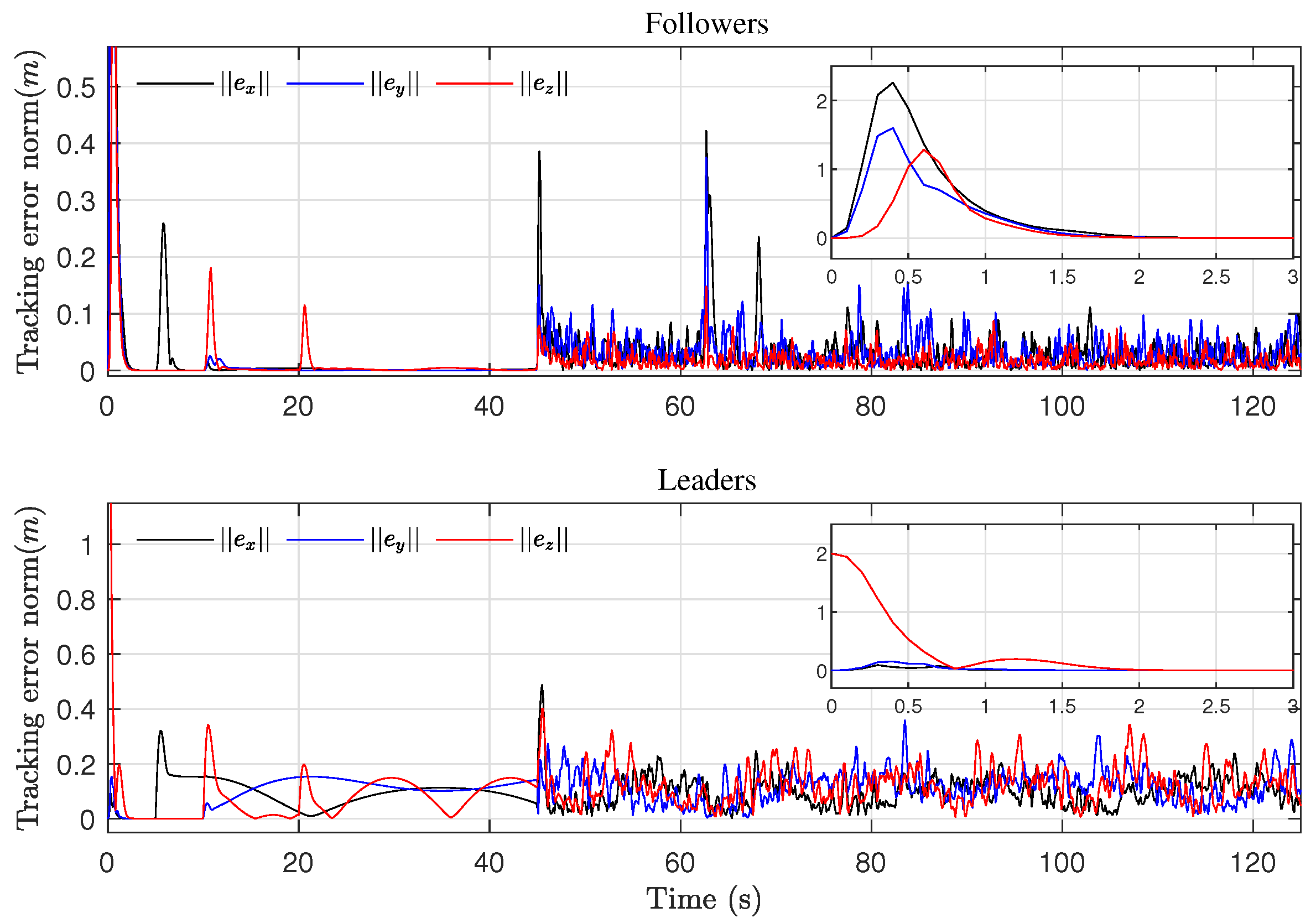1. Introduction
Recently, the incorporation of robotics into social functions has garnered significant attention, leading to the practical deployment of multi-robot systems in diverse areas, including entertainment, agricultural automation, and defense applications [
1]. This surge in interest has prompted significant attention towards cooperative robotic systems, which present complex challenges, notably in guiding these robotic ensembles effectively toward their intended objectives. Cooperative control is the key to ensuring seamless interaction and coordination between system components, enabling the successful navigation of the environment and execution of tasks. Rotary-wing unmanned aerial vehicles (UAVs), with their inherent stability, vertical take-off and landing capabilities, and precise hovering abilities, exemplify the potential of such systems, particularly in tasks such as surveillance, inspection, and target tracking [
2]. Thus, interest in cooperative robotics continues to expand across various sectors, including agriculture [
3], industrial production [
1], and inventory management [
4]. The versatility of UAVs has been increasingly recognized for their ability to cover expansive territories and access remote or challenging locations.
In light of this, as the number of robots interacting with each other increases, we see an escalation in system complexity and data load. Distributed control strategies, such as consensus, containment, and formation control, provide an effective solution to mitigate these challenges. Consensus algorithms enable all agents in a network to agree on a common state using only the information exchanged through the communication network, as elaborated in [
5,
6]. In systems without defined leaders, the primary control objective is to ensure consensus formation on the estimated states of the neighboring elements of the system, as discussed in [
7,
8,
9].
The leader–follower approach helps to manage the amount of information shared within a system. For instance, in situations requiring constant communication with a base of operations, limiting the number of agents who send or receive data can prevent communication overload. To achieve this, a smaller group of agents is designated as the leaders. These leaders receive trajectory information and guide the rest of the agents, considered followers, through a consensus process. Several issues have been identified in this kind of system—such as convergence coordination in [
10]—when considering uncertainties in the trajectory and the system in [
11], addressing communication reliability [
12,
13,
14], robustness to disturbances [
15], and control of heterogeneous systems [
16]. Given the complexity inherent in multi-agent system applications, effective task execution necessitates adaptive and dynamic interactions among the agents. When multiple leaders are used to define the shape of the formation, this is known as containment control. In this setup, followers do not send information back to leaders, meaning that the consensus does not directly control the leaders; instead, it uses them as reference points. This introduces uncertainty, especially when guiding followers through dynamic formations or unfamiliar paths. Regardless of this new challenge, the flexibility to transmit information exclusively to leaders and adjust the formation as required provides significant advantages. Hence, the formation-containment strategy offers a more practical implementation by directing the leaders to achieve a predefined formation while ensuring that the followers remain confined within the convex hull defined by the leaders. In [
17,
18] , a dynamic strategy for implementing formation-containment control in linear multi-agent systems is proposed. Reacting to the environment presents the problem of formation, which changes over time, as a crucial topic [
19].
Implementing UAV systems in confined indoor environments presents challenges, including size limitations and a high risk of collisions with obstacles. Micro air vehicles (MAVs) are well-suited for such settings due to their compact design. Still, their limited size and weight restrict the integration of complex sensor systems within a single unit. In addition, MAVs are highly sensitive to external disturbances. When multiple agents operate in the same space, the risk of mutual interference increases significantly. As a result, robust solutions are crucial for effectively managing external perturbations and system uncertainties. Adaptive control schemes have been investigated to effectively address this issue in linear systems, particularly in first- and second-order multi-agent systems [
20,
21,
22,
23]. However, they often fail to consider the full dynamics of the agents and do not account for perturbations.
Another challenging issue when working with multi-agent systems is the need for agents to avoid collisions with one another. As with numerous MAVs, the possibility of collision poses a significant threat that could result in the loss of multiple agents. Solutions to coordinate trajectories and avoid collisions of low-complexity multi-agent systems were presented in [
24,
25,
26]. In [
27,
28], the formation problem of multi-agent systems was studied while avoiding collision, but perturbations were not considered.
This paper presents a novel and robust formation-containment control framework for a fleet of quadrotor micro aerial vehicles (MAVs) operating in uncertainty and susceptible to disturbance environments. The key innovation lies in a single-gain adaptive sliding mode control (SGASMC) strategy that guarantees practical finite-time convergence in the presence of external disturbances—modeled using the Von Kármán turbulence model—and system uncertainties. Unlike traditional approaches, the proposed method enables follower agents to track a dynamically evolving convex hull defined by leader agents with unknown control inputs, while also ensuring real-time sensor-less inter-agent collision avoidance and trajectory tracking within confined, time-varying environments.
The controller adaptively estimates and minimizes control gains. This approach avoids overestimation, thereby improving control efficiency and responsiveness. A Lyapunov-based stability analysis confirms finite-time convergence and robustness. Simulation results incorporating the full nonlinear quadrotor dynamics of the quadrotor to validate the framework’s effectiveness. The system achieves robust containment, integrated collision avoidance, and accurate trajectory tracking under realistic aerodynamic disturbances.
The proposed method offers a scalable and adaptable control solution for real-world MAV applications, particularly in dynamic and uncertain indoor environments.
The rest of this work is organized as follows:
Section 2 covers preliminary concepts and the problem formulation.
Section 3 presents the proposed formation-containment controller and the stability analysis. Simulation results are presented in
Section 4. Finally, in
Section 5, conclusions are drawn.
3. Formation Collision-Free Containment Control Design
In this section, the design of the proposed formation and collision-free containment controller is described, where control law designs were based on a class of adaptive sliding mode controllers. This implementation employs a two-layer strategy. Initially, the leaders track a desired trajectory using a virtual leader as a reference. Then, the followers converge within the convex hull formed by the leaders.
Figure 1 presents the interactions among followers, leaders, and a virtual leader.
The system considers a virtual leader. Using its position as a reference for the formation of the leader subgroup, the reference state is defined as
We denote a formation matrix within , describing the desired formation of the leaders. Since this work evaluates the problem of time-varying formations, let us define the following assumption.
Assumption 2. The formation vectors for all are piecewise continuously differentiable.
To achieve formation tracking, for all leaders with any initial conditions, the system should satisfy the following:
As such, desired formation positions are defined as
. Thus, a tracking error is established as
Then, to lay the foundation of containment, the following assumption is stated:
Assumption 3. The complete state of MAVs is assumed to be available to its neighbors.
This study focuses on the control strategy to ensure collision-free containment of a MAV fleet, integrating the dynamics of each follower and the corresponding containment control law. To establish formation and collision-free containment, considering the flight capabilities of the quadrotors, such as their ability to vertically take-off and land, hover, and perform high-maneuverability maneuvers within a 3D workspace, it is assumed that each agent is equipped with a low-level controller enabling free maneuverability. A reduced tracking model is used to determine the desired positions for formation and containment with respect to the inertial frame
I [
29]:
with accelerations
,
,
in
coordinates, while
and
denote velocities with respect to the body frame {B
i} and Ω is the angular acceleration in yaw.
From the model (
10),(
11),(
12),(
13), and considering a vector state as
of each agent, the system is rewritten as follows:
with
where
is the control command. The perturbations and uncertainties are represented by
satisfying
, with
denoting the perturbation boundary. Now, based on Assumption 1, to satisfy coordinated containment, the positions and velocities desired for the
i-th follower are defined as follows:
where
and
are the leader
-th states. Subsequently, the containment error is formulated as
and their derivative corresponds to
Now, since the containment error is calculated individually for each follower based on the current positions of the leaders, the actual trajectories of the followers to reach the desired position may generate collisions during the convergence phase. Thus, to guarantee collision-free convergence for the followers, the following strategy is adopted:
where the error is expanded by the desired distance relative to all neighbor agents
, this adds a repelling effect, making agents pursue their desired positions while maintaining proportional distances from each other, thus assuring (
6). Using the same information as that for the containment error, we construct
. To simplify computation, the containment error is expressed as matrix multiplication:
where
describes the states of all agents in the system,
is an identity matrix whose size is ∗, and
s is the number of states of each agent. The desired distance relative to the neighbors is given by
By substituting Equations (
21) and (
23) into (
20), we obtain the following:
Due to the fact that
is a constant matrix and judging by the properties established in the Assumption 1, we know that all its eigenvalues are non-positive. Now, the error time derivative result is as follows:
Then, to design the formation and collision-free containment control, using the SGASMC strategy, a containment sliding surface is denoted as:
where
is the diagonal matrix representation of the vector
such that
and the time derivative of (
26) is given by
The control aims to achieve
. Thus, the next feedback control is adopted:
where the auxiliary controller
is applied using a single-gain adaptive sliding mode strategy, as detailed in
whose adaptation of
is governed by
with
and
being positive and representing the precision and control effort parameters, respectively.
is usually a small value as it helps minimize oscillation and smooth the control action.
is generally larger, controlling the rate at which the adaptive gain grows; however, as its value increases, the adaptation becomes more aggressive, leading to higher energy consumption. The advantages of the proposed controller (
29) and adaptation (
30) include robustness against external disturbances, avoidance of overestimation of controller gains, reduction in control parameters and achieving finite-time convergence.
Stability Analysis
The stability of the formation-containment closed-loop system is presented. Let us first consider the following definition and lemma, respectively.
Definition 1 ([
30])
. Considering a nonlinear systemwhere ξ is a state vector, U is the input vector.
The solution is practical finite-time stable if for all there exists a and a time , such that , for all . Lemma 1 ([
30])
. Consider a nonlinear system (31), and assume there exists a continuous positive-definite function and scalars , and such thatthe system is practical finite-time stable. Therefore, the trajectories of the closed-loop system are bounded in finite time aswhere .
Therefore, the trajectories of the closed-loop system are bounded in finite time by Now, the stability of the system can be expressed by the following theorem.
Theorem 1. A system considering the formation-containment controller (
28)
with adaptive law (
30)
in a closed-loop with a 3D tracking model (10),(11),(12),(13) for a mini quadrotor fleet is practical finite-time stable and converges at time . Proof. The closed-loop stability can be assessed by examining the dynamics of the formation-containment sliding surface when integrated with the controller (
28), which is expressed by
To simplify the analysis, and since
is a diagonal matrix, each of its values individually affects only one of the states of the system; it is possible to continue the closed-loop stability analysis as follows:
Now, consider the following Lyapunov function candidate:
where
is a gain upper-bound, which exists but is unknown, and counteracts the perturbation, such that
. Then, by differentiating such a Lyapunov function candidate, we have
where introducing (
36) into (
37) leads to
Given this includes only dot products and Hadamard products, it can be rewritten as
Now, by introducing the following parameters and knowing that
one can express the above equation as
Consider
and let
, then
From the definition of
and
, it is possible to conclude that
and
are positive-definite symetric matrices. Thus, by Rayleigh’s principle,
where
is the minimum eigenvalue of *. Then,
with
. The above equation can be rewritten according to Lemma 1, resulting in the following:
where
. Thus,
is practical finite-time stable if
. Notice that
must be positive to guarantee stability; in that way, two cases arise:
Case 1. When the sliding mode is achieved, i.e., and if due to the fact that and are positive defined, then .
Case 2. For the reaching phase and if , one can choose to allow .
This completes the proof. □
For low-level control and modeling, the results from [
31] guided the development of a control strategy for a six-degree-of-freedom quadrotor model, which reflects the cross configuration and uses these parameters:
l = 0.058 m,
g = 9.81 m/s
2,
m = 0.060 kg,
=
kgm
2,
=
kgm
2,
=
kgm
2,
=
kgm
2. The flight controller is divided into two parts: an attitude controller for the
angles in the body frame, and a position controller for the
coordinates in the inertial frame. The controllers are implemented as presented in [
29]. This approach enables the calculation of the torques, thrusts, and desired angles required for free maneuverability in a 3D workspace.
4. Simulation Results
This section presents the evaluation of the proposed three-dimensional formation-containment control strategy for a fleet of quadrotor micro aerial vehicles. The simulation was implemented in the MATLAB/Simulink R2020b environment, incorporating both the control algorithm and a dynamic quadrotor model for each agent.
Figure 3 illustrates the control loop that integrates the two control layers. The proposed SGASMC controls the tracking model to set the trajectory of each agent, and low-level attitude and position control ensures maneuverability. The simulated system consists of eight agents: four followers, denoted as
–
, and four leaders, as
–
. The interactions among the agents are depicted in
Figure 1.
Simulations were conducted using a fixed step size of s. To demonstrate the effectiveness of the proposed approach, the test trajectory was designed to represent several common scenarios in multi-agent systems missions, including static and dynamic convergence, robustness to perturbations, and time-varying formations.
The Von Kármán turbulence model is used to simulate atmospheric wind disturbances affecting unmanned aerial vehicles. It provides a realistic representation of wind turbulence by modeling the power spectral density of velocity fluctuations based on assumptions of homogeneous turbulence. Compared to simpler models, this model more accurately captures the spatial and temporal characteristics of wind disturbances encountered by UAVs, making it suitable for high-fidelity simulation, flight dynamics analysis, and control system design. The dedicated block for Von Karman wind turbulence provided by Simulink was used in this simulation.
The complete description of the test is presented in
Figure 4. The inicial conditions of the system are as follows:
,
,
,
,
,
,
,
. All agents are considered to have the same characteristics, and as such, the control parameters are the same for each agent:
,
, and
. The first phase involves followers converging to their designated reference point within a region defined by the leaders. During this phase, the leaders are arranged in a square formation, and the followers are expected to converge to the containment while avoiding collisions with both each other and the leaders. Once containment is achieved, the second phase commences. In this phase, the leaders follow a trajectory in the shape of a 3D infinity, as shown in
Figure 5 and
Figure 6. Furthermore, to evaluate robustness, a turbulent wind perturbation using the Von Kármán model is applied starting at
s and for the remainder of the test. Its magnitude is presented in
Figure 7. Under such perturbations, and given the quadrotor’s small size, the disturbance magnitude presents a considerable challenge not only to maintain a stable flight but also to avoid collisions along the trajectory. At
s, the leaders’ formation changes from a square to a tetrahedral shape. In this phase, followers pursue new desired positions that reflect the modification of the leader’s formation, while maintaining the same interaction network. Finally, in the last phase, the system continues to follow the trajectory with the new formation and under the turbulent wind perturbation. A video of the simulation is attached to illustrate the system’s dynamic response. This video (
Video S1) visualizes results by importing simulation data for a full 6-degree of freedom quadrotor model for each agent and disturbances using the Von Kármán wind turbulent model from MATLAB/Simulink into the CoppeliaSim Edu, Version 4.3.0 environment.
To clarify the distinction between the normal containment error and the proposed collision avoidance error,
Figure 8 and
Figure 9 display the convergence phase behaviors side by side for each control approach, using data from the first 5 s of the experiment. With the standard containment strategy, followers aim for their target positions by the shortest path. This can result in collisions, especially if the initial setup causes their paths to cross. For demonstration, the initial conditions were specifically chosen to create intersecting trajectories, illustrating how followers often reach their assigned altitude simultaneously and cross paths, which increases the risk of collision. In contrast, subsection (b) of the figures demonstrates the effects of the proposed collision avoidance error. Here, followers do not move directly to their desired positions. Instead, the control adjusts each follower’s trajectory to avoid the expected desired positions of nearby agents. For example, follower F1 approaches its desired position from above, overshooting the required altitude before descending to it. F4, in turn, stays lower and follows a rising arc to join the formation from below. F2 and F3 show milder adjustments; F2 adds a slight curve to its path, giving F3 enough space to approach its position almost directly. This coordinated avoidance is achieved without relying on external sensors. Each follower maintains a safe distance using only the interaction network matrices and information shared by its neighbors. The followers’ desired positions are determined by the submatrix
from
, which remains constant unless the network topology changes. As a result, any follower with access to the leaders’ positions can calculate both its own and its neighbors’ desired positions, enabling decentralized and collision-free convergence.
Key system performance parameters are illustrated in the figures that follow.
Figure 10 shows the norm of the position error and control input for the follower agents. The error represents the deviation between the actual follower positions and the desired positions defined by the convex hull formed by the leaders. This serves as an indicator of the containment performance, which is also illustrated in the lower panel of the figure, demonstrating that the magnitude of the control effort is within the capabilities of the MAVs.
Figure 11 displays the evolution of the adaptive control gains for the followers under turbulent wind conditions. The variations in these gains reflect the controller’s real-time adaptation to external disturbances, highlighting its ability to maintain stability and performance despite environmental perturbations.
Figure 12 presents the tracking error norm for both followers and leaders. This error quantifies each agent’s deviation from its respective reference trajectory, providing a measure of the overall system tracking performance. While the error exhibits spike increases, these are primarily due to the inertial effects inherent in the quadrotor dynamics. Importantly, these fluctuations remain within the allowable performance bounds of the vehicles. Notably, the leaders experience greater deviations than the followers under wind disturbances. This disparity occurs because the convex hull, which defines the formation, moves in response to leader displacement caused by disturbance. Conversely, the virtual leader, unaffected by atmospheric turbulence, continues along its predetermined trajectory, causing the leaders to exhibit a greater deviation from the ideal path under turbulent conditions.
To further validate the effectiveness of the proposed controller,
Figure 13 compares the performance of three control strategies in terms of the error norm, control effort norm, and integral absolute error (IAE) norm. All controllers were implemented within the same feedback linearization framework, with the control input
replaced by a conventional PID controller, an adaptive sliding mode controller (ASMC) [
29], and the proposed SGASMC. As shown in the figure, all three controllers successfully maintained system stability under moderate Von Kármán wind disturbances. However, notable differences in performance are observed. The PID controller, lacking adaptive ability, exhibited greater difficulty in compensating for disturbances, resulting in higher error and control effort. In contrast, the two adaptive controllers, ASMC and SGASMC, demonstrated significantly better disturbance rejection, as reflected in their lower control effort norms. Among the adaptive strategies, the SGASMC exhibited a clear advantage in terms of adaptation speed. This is particularly evident in the IAE plot, where SGASMC shows a consistently lower growth rate, indicating faster convergence and more effective error suppression. These results highlight the superior performance of SGASMC in dynamic and uncertain environments compared to both ASMC and PID controllers.

